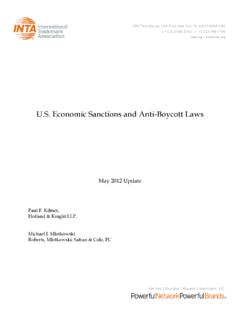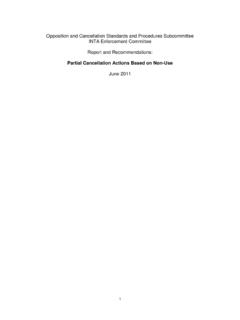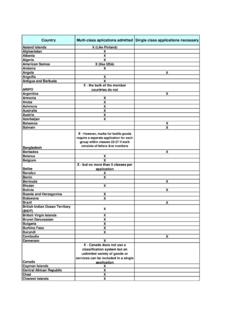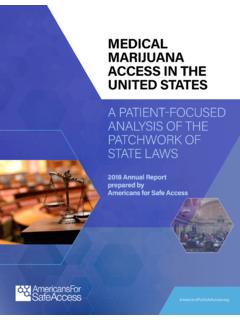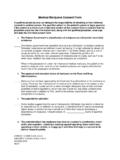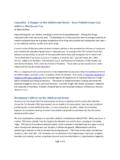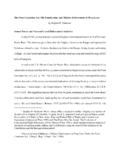Transcription of Christopher R. McElwain
1 High Stakes: marijuana Brands and the USPTO's [Lawful] Use Registration Criterion Christopher R. McElwain I. Introduction In his history of Prohibition, author Daniel Okrent writes about the black market's effects on American drinking habits: Speakeasy liquor could have been anything from single-malt Scotch smuggled by way of Nassau to diluted embalming fluid.. In the saloon era, calling for liquor by brand name was almost unheard of; in the speakeasy era, it became a habit, first as a means of protecting oneself from alcohol of questionable origin, and secondarily as a way pf expressing one's level of taste.. When he was building his own brand, Tommy Dewar publicized the perilous alternative the liquor of unknown provenance he once characterized as squirrel whiskey, so called because, he said it will make men nutty and climb trees. It will send the average Sunday School teacher walking ten miles through three feet of snow to shoot his own parson. Naturally, there was an alternative: Drink Dewar's!
2 Decades later, many of the liquor industry's best-known brands owed their prominence to the ubiquity of Prohibition-era During Prohibition, in a black market flooded with back-alley moonshine and poisonous denatured industrial alcohol,2 consumers clung to trademarks as a shorthand for quality. Unfortunately, counterfeiting was predictably widespread, as bootleggers routinely refilled bottles of brand-name imports with whatever they could lay their hands [I]n too many place, Okrent writes, if you ordered Brand X, you got Brand X; if you ordered Dewar's or Gordon's, you paid twice as much and got Brand X. 4. Nearly a century later, a similar situation has arisen. Twenty-three states and the District of Columbia have passed laws legalizing marijuana for medical use, and four states and have legalized the drug for recreational use as Several other states are expected to vote on 1. Daniel Okrent, LAST CALL: THE RISE AND FALL OF PROHIBITION, 209-210 (Scribner 2010).
3 2. Edward Behr, PROHIBITION: THIRTEEN YEARS THAT CHANGED AMERICA, 163 and 222 (Arcade Publishing 1996). 3. Id. (noting that in 1926, over 660,000 gallons of often-lethal industrial alcohol found their way into the black and grey alcohol markets). Such activities continue even today. See Robert M. Tobiasse, The Fake Alcohol Situation in the United States: The Impact of Culture, Market Economics and the Current Regulatory Systems (2014) at 21-22, available at 4. Okrent, supra note 1, at 211. 5. See Miriam D. Trudell, marijuana in the Some States Let You Smoke It, But You Can't Register a Trademark for It at the USPTO, INTAB ulletin, Vol. 70, No. 14 (August 1, 2015), legalization in Yet, sale, distribution and possession of the drug remain Class 1 felonies under the Controlled Substances Act (CSA).7. Due to this continuing prohibition, cannabis is stuck in the era of the speakeasy. Consumers confront toxic pesticides and other dangers8 and struggle to evaluate goods that are exceptionally variable in quality and Names of particular cannabis strains serve as de facto brands, but there is no mechanism ensuring the authenticity of purported varietals, and supposed markers of quality like Jack Herer and OG Kush are probably largely There is enormous incentive to develop reliable cannabis brands, to create what cannabis entrepreneurs hope will be the Dewar's and Gordon's of the post-prohibition And, indeed, as discussed in Part II, an explosion of cannabis-related trademark applications over the last six years attests to the perceived need among cannabis businesses to protect the goodwill associated with their products.
4 Under current trademark law, as interpreted and implemented by the Patent and Trademark Office (USPTO), it is not possible to obtain a federal trademark registration in connection with marijuana since such registrations are held to violate the USPTO's rule that trademarks must be in lawful use in commerce (referred to herein as the Lawful Use Rule).12. As explained in Part III, the Lawful Use Rule is questionable as a matter of statutory construction, but it is well established by decades of case law emanating from the Trademark Trial and Appeal Board (TTAB). The rule is also questionable as a matter of public policy, since encouraging trademark infringement with respect to cannabis products does not appear serve the purposes of either the Lanham Act or the CSA. As explored in Part IV, cannabis brand owners can still rely on the common law's protection, register their trademarks with state agencies or attempt to secure federal protection in connection with ancillary goods and services.
5 But the inability to obtain a 6. California, Nevada, Maine, Arizona and Massachusetts are all expected to consider legalizing recreational marijuana use in 2016. 2016: The marijuana Election, NEWSWEEK (August 1, 2015), available at 7. 21 812, 841(a)(1), 844(a). 8. Andy Campbell, Dangerous Pesticides Are Being Found In Colorado's Weed, THE HUFFINGTON POST, 9. According to crowdsourced data gathered by the website , the price per ounce of low quality . marijuana around August, 2011 was $ , compared with $ for high quality marijuana , Matthew Zook, Mark Graham and Monica Stephens, Data Shadows of an Underground Economy: Volunteered Geographic Information and the Economic Geographies of marijuana (Floating Sheep Working Paper) (August 30, 2011), available at Y2Ez/view. 10. Dennis Romero, marijuana Strains like OG Kush Are Meaningless, Expert Says, WEEKLY (Dec. 3, 2013), available at 11. See Robert Klara, Who Will Become the Starbucks of Pot?, AD WEEK (July 27, 2014), available at 12.
6 See Trudell, supra note 5. USPTO registration remains a crucial shortcoming. Without it, cannabis manufacturers have significantly less incentive to invest in quality, safety and sustainability. Consumers are at perpetual risk of being misled. And a patchwork field of conflicting trademark claims is being sown that will encourage wasteful litigation as the cannabis market expands. The Lawful Use Rule has not been extensively addressed by federal courts (with the notable exception of the Ninth Circuit), and the possibility remains that it might be struck down upon appeal. Until then, or until the situation is addressed by Congress, cannabis brands are unlikely to be afforded the same protection as other marks used in interstate commerce. II. Trademark Activity in the Cannabis Industry A. Cannabis Brands Generally In 2014, the kind-of-legal market for cannabis (sales permitted under state law) drew in revenues estimated at over $2 With black market sales estimated at anywhere between $10.
7 Billion and $120 billion annually,14 the size of this quasi-legitimate industry is expected to expand dramatically in the coming Cannabis branding is in its infancy but expanding Despite the present barriers to interstate expansion, numerous companies, such as Colorado-based Dixie Elixers, are positioning themselves to become national At the same time, the industry is showing increasing interest in protecting and enforcing its trademarks. Thus far, the majority of high-profile trademark infringement claims have been brought by owners of non-cannabis For example, in June, 2014, Hershey sued Colorado edibles-maker Tincturebelle over several THC-laced parody brands (including HASHEE's (REESE's) and GANJA JOY (ALMOND JOY)).19 Similarly, a few months later, MGM sued a Nevada medical dispensary to prevent their use of the name M'LIFE (alleged to be similar to the casino's M Life guest rewards program).20 However, there are also sporadic cases of cannabis businesses attempting to protect their own goodwill, generally in the context of former partners or employees vying for control of a 13.
8 Anne Holland, New Forecast: MMJ and Recreational Cannabis Sales to Hit $8 Billion by 2018, marijuana . BUSINESS DAILY (April 4, 2014), cannabis-sales-to-hit-8-billion-by-2018/ . 14. Ariel Nelson, How Big Is The marijuana Market?, CNBC (April 20, 2010), 15. Holland, supra note 13. 16. See Klara, supra note 11. 17. Rob Reutman, Dixie Elixirs Wants to Become the First National marijuana Brand, ENTREPRENEUR (June 2014), available at 18. See Notes 19-20, infra. 19. The Hershey Company v. Tincturebelle, LLC, 14-cv-01564 (Dist. CO) (June 3, 2014). 20. MGM Resorts International v. M'Life, Inc., 14-cv-01510 (Dist. NV) (Sept. 17, 2014). 21. A marijuana edibles firm, Green Cross Colorado, LLC, recently sued a former employee in state court, claiming, among other things, infringement of its EDI-PURE trademark. George Demopoulos, Claiming copycat candies, A more obvious sign of the cannabis industry's interest in trademarks is the swell in applications to the USPTO for registration of marks in connection with goods or services involving marijuana .
9 B. The Explosion of Cannabis-related Trademark Applications The recent upsurge in cannabis-related trademark activity before the USPTO is tough to The oldest record related to marijuana in the USPTO's Trademark Status & Document Retrieval (TSDR) database belongs to the Upjohn Company. From 1931 to 2002, the pharmaceutical manufacturer held a registration for its UPJOHN house mark in connection with a variety of drugs, including cannabis extract. 23 But between Upjohn's 1931 application and roughly the second half of 2009, trademark applications related to marijuana were few and far Before June 30, 2009, only 120 applications mention cannabis or marijuana , and, of these, only about 30 seem to refer to goods that would be prohibited under the CSA,25 as opposed to, for example, the National Organization for the Reform of marijuana Laws' long-standing 1973. registration for NORML in Class 42 (educational services).26 With the single exception of the Upjohn registration, no trademark registration appears to have issued during this period in connection with products that would be prohibited by the On February 25, 2009, however, Attorney General Eric Holder announced that the federal Drug Enforcement Administration (DEA) would no longer raid medical- marijuana facilities in the 13 states that had then legalized the A few months later, there was a sudden spike edibles maker goes to court, BUSINESSDEN (October 21, 2015), available at See also ComfyTree Enterprises, LLC v.
10 Foster, Opposition No. 91219637 (applications filed by former employee for the marks COMFYTREE and CANNABIS ACADEMY). 22. A spreadsheet of all trademark applications in in the TSDR database containing the words marijuana , . cannabis, or THC within the identification of goods and services as of December 14, 2015 is available upon request from the author. This list, containing 1,261 entries, is doubtless both underinclusive and overinclusive. For example, it does not account for cannabis-related applications that may use more general, obscure or euphemistic terms for the relevant goods and services. At the same time, it captures applications for marks related to anti-drug awareness services and the like, which have little relevance to the subject of this paper. This method's shortcomings notwithstanding, however, the numbers are striking. 23. Registration No. 289473. Prior to the 1937 Marihuana Tax Act, cannabis-derived medicines were commonplace in the pharmaceutical industry.
